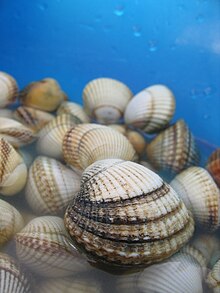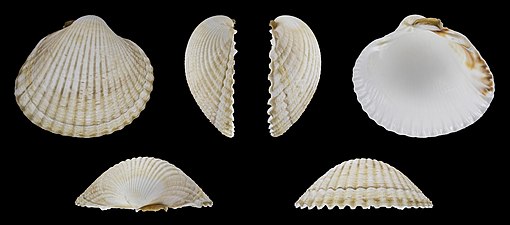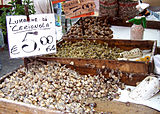
Clam is a common name for several kinds of bivalve molluscs. The word is often applied only to those that are edible and live as infauna, spending most of their lives halfway buried in the sand of the seafloor or riverbeds. Clams have two shells of equal size connected by two adductor muscles and have a powerful burrowing foot. They live in both freshwater and marine environments; in salt water they prefer to burrow down into the mud and the turbidity of the water required varies with species and location; the greatest diversity of these is in North America.

A cockle is an edible marine bivalve mollusc. Although many small edible bivalves are loosely called cockles, true cockles are species in the family Cardiidae.
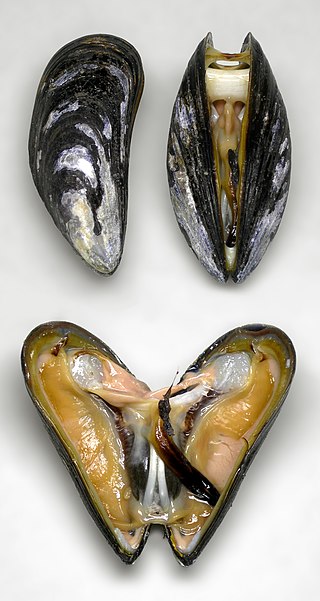
The blue mussel, also known as the common mussel, is a medium-sized edible marine bivalve mollusc in the family Mytilidae, the mussels. Blue mussels are subject to commercial use and intensive aquaculture. A species with a large range, empty shells are commonly found on beaches around the world.

Cancer pagurus, commonly known as the edible crab or brown crab, is a species of crab found in the North Sea, North Atlantic Ocean, and perhaps the Mediterranean Sea. It is a robust crab of a reddish-brown colour, having an oval carapace with a characteristic "pie crust" edge and black tips to the claws. A mature adult may have a carapace width up to 25 centimetres and weigh up to 3 kilograms. C. pagurus is a nocturnal predator, targeting a range of molluscs and crustaceans. It is the subject of the largest crab fishery in Western Europe, centred on the coasts of the British Isles, with more than 60,000 tonnes caught annually.

Carcinus maenas is a common littoral crab. It is known by different names around the world. In the British Isles, it is generally referred to as the shore crab, or green shore crab. In North America and South Africa, it bears the name European green crab.
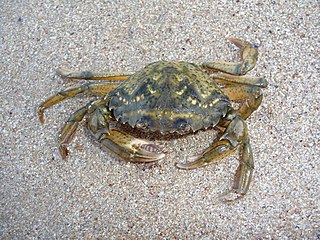
Carcinus aestuarii, also known as the Mediterranean green crab is a littoral crab, native to the Mediterranean Sea.
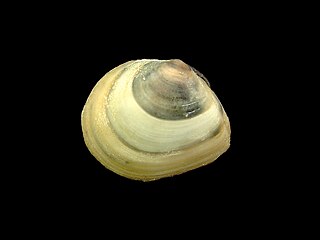
Limecola balthica, commonly called the Baltic macoma, Baltic clam or Baltic tellin, is a small saltwater clam, a marine bivalve mollusk in the family Tellinidae.

Cerastoderma is a genus of marine bivalves in the family Cardiidae. It includes the common cockle Cerastoderma edule.

Tegillarca granosa is a species of ark clam known as the blood cockle or blood clam due to the red haemoglobin liquid inside the soft tissues. It is found throughout the Indo-Pacific region from the eastern coast of South Africa northwards and eastwards to Southeast Asia, Australia, Polynesia, and up to northern Japan. It lives mainly in the intertidal zone at one to two metres water depth, burrowed down into sand or mud. Adult size is about 5 to 6 cm long and 4 to 5 cm wide.
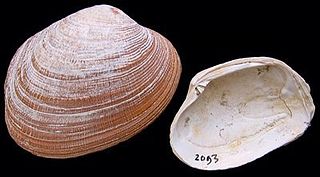
The grooved carpet shell, or Palourde clam, Ruditapes decussatus, or Venerupis decussatus, is a clam in the family Veneridae. It is distributed worldwide and is highly prized due to its ecological and economic interest. It has been proposed as a bioindicator.

Mya truncata, common name the blunt gaper or truncate softshell, is a species of edible saltwater clam, a marine bivalve mollusk in the family Myidae.
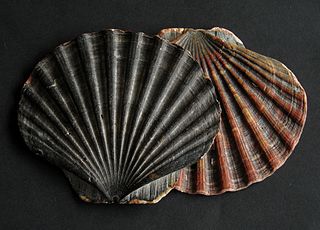
Pecten maximus, common names the great scallop, king scallop, St James shell or escallop, is a northeast Atlantic species of scallop, an edible saltwater clam, a marine bivalve mollusc in the family Pectinidae. This is the type species of the genus. This species may be conspecific with Pecten jacobaeus, the pilgrim's scallop, which has a much more restricted distribution.

Liocarcinus depurator, sometimes called the harbour crab or sandy swimming crab, is a species of crab found in the North Sea, Atlantic Ocean, Mediterranean Sea, and Black Sea. It grows up to 50 millimetres (2.0 in) in width and 40 mm (1.6 in) long, and can be distinguished from other crabs, such as the shore crab Carcinus maenas, by the curved rows of white spots on its carapace.
Haplosporidium is a genus under order Haplosporida.
Marteilia is a protozoan genus of organisms that are parasites of bivalves. It causes QX disease in Sydney rock oysters and Aber disease in European flat oysters. After being infected by Marteilia, bivalves lose pigmentation in their visceral tissue, and become emaciated.

Around 65 species of crab occur in the waters of the British Isles. All are marine, with the exception of the introduced Chinese mitten crab, Eriocheir sinensis, which occurs in fresh and brackish water. They range in size from the deep-water species Paromola cuvieri, which can reach a claw span of 1.2 metres, to the pea crab, which is only 4 mm (0.16 in) wide and lives inside mussel shells.

Cerastoderma glaucum, the lagoon cockle, is a species of saltwater clam, a marine bivalve mollusc in the family Cardiidae, the cockles.

Acanthocardia echinata, the prickly cockle or European prickly cockle, is a species of saltwater clam, marine bivalve molluscs in the family Cardiidae.
